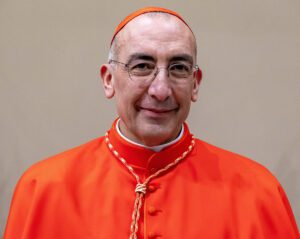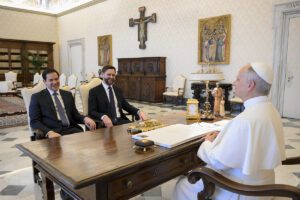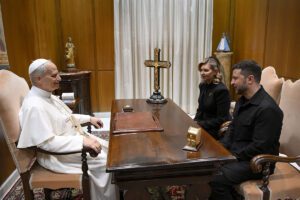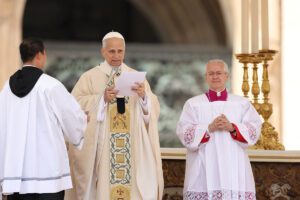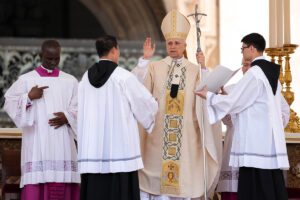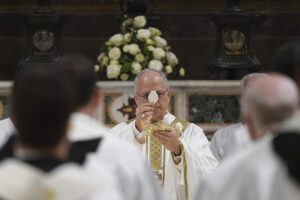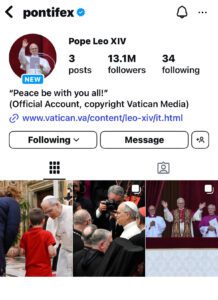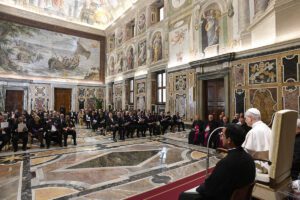ROME (CNS) – God’s love, mercy and goodness lie at the foundation of every vocation, including that of the pope, Pope Leo XIV said.
“Let us ask the Lord for the grace to cultivate and spread his charity and to become true neighbors to one another,” he said, paraphrasing his predecessor, Pope Francis, in a homily at Rome’s Basilica of St. Paul Outside the Walls May 20.
“Let us compete in showing the love that, following (St. Paul’s) encounter with Christ, drove the former persecutor to become ‘all things to all people,’ even to the point of martyrdom,” he said.
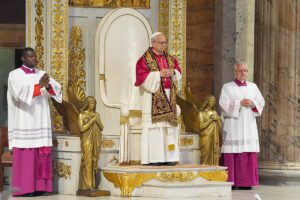
The pope visited the basilica and tomb of St. Paul two days after the Mass for the inauguration of his Petrine ministry in St. Peter’s Square. It was part of a series of visits to the city’s major papal basilicas after his election.
People cheered and applauded as he entered the basilica, and he blessed the crowds. He walked to the steps descending to the apostle’s tomb where he knelt briefly in silent prayer.
The prayer service was dedicated to St. Paul, the so-called “Apostle to the Gentiles” who brought the Gospel to peoples across the central and eastern Mediterranean, exemplifying evangelical zeal and the missionary spirit. The visit was part of entrusting “the beginning of this new pontificate to the intercession of the apostle,” the pope said.
Pope Leo’s homily reflected on a reading chosen from the opening of Paul’s Letter to the Romans, where the apostle expresses his complete allegiance to the Lord and his faith in God’s justifying action in Jesus.
St. Paul received the grace of his vocation from God, acknowledging “that his encounter with Christ and his own ministry were the fruit of God’s prior love, which called him to a new life while he was still far from the Gospel and persecuting the church,” the pope said.
St. Augustine also was a convert who experienced choosing God after having realized God had chosen him first, he said. “We cannot love unless someone has loved us first.”
In fact, “at the root of every vocation, God is present, in his mercy and his goodness, as generous as that of a mother who nourishes her child with her own body for as long as the child is unable to feed itself,” he said, quoting from the saint who founded the religious order he joined in his 20s.
When St. Paul speaks of “the obedience of faith,” he said, he is referring to what happened to him on the road to Damascus, when the Lord appeared and “did not take away his freedom, but gave him the opportunity to make a decision, to choose an obedience that would prove costly and entail interior and exterior struggles, which Paul proved willing to face.”
“Salvation does not come about by magic, but by a mysterious interplay of grace and faith, of God’s prevenient love and of our trusting and free acceptance,” he said.
Quoting from Pope Benedict XVI’s 2011 address to young people, Pope Leo said, “‘God loves us. This is the great truth of our life; it is what makes everything else meaningful.’ Indeed, ‘our life originates as part of a loving plan of God.'”
“Faith leads us to ‘open our hearts to this mystery of love and to live as men and women conscious of being loved by God,'” he continued.
“Here we see, in all its simplicity and uniqueness, the basis of every mission, including my own mission as the successor of Peter and the heir to Paul’s apostolic zeal. May the Lord grant me the grace to respond faithfully to his call,” he said.
After praying before the altar above the apostle’s tomb, Pope Leo concluded the service and processed out the basilica, again to applause, blessing those present and making the sign of the cross on the foreheads of several babies.

